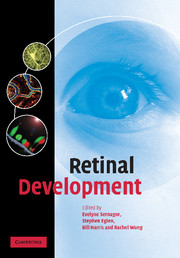Book contents
- Frontmatter
- Contents
- List of contributors
- Foreword
- Preface
- Acknowledgements
- 1 Introduction – from eye field to eyesight
- 2 Formation of the eye field
- 3 Retinal neurogenesis
- 4 Cell migration
- 5 Cell determination
- 6 Neurotransmitters and neurotrophins
- 7 Comparison of development of the primate fovea centralis with peripheral retina
- 8 Optic nerve formation
- 9 Glial cells in the developing retina
- 10 Retinal mosaics
- 11 Programmed cell death
- 12 Dendritic growth
- 13 Synaptogenesis and early neural activity
- 14 Emergence of light responses
- New perspectives
- Index
- Plate section
- References
5 - Cell determination
Published online by Cambridge University Press: 22 August 2009
- Frontmatter
- Contents
- List of contributors
- Foreword
- Preface
- Acknowledgements
- 1 Introduction – from eye field to eyesight
- 2 Formation of the eye field
- 3 Retinal neurogenesis
- 4 Cell migration
- 5 Cell determination
- 6 Neurotransmitters and neurotrophins
- 7 Comparison of development of the primate fovea centralis with peripheral retina
- 8 Optic nerve formation
- 9 Glial cells in the developing retina
- 10 Retinal mosaics
- 11 Programmed cell death
- 12 Dendritic growth
- 13 Synaptogenesis and early neural activity
- 14 Emergence of light responses
- New perspectives
- Index
- Plate section
- References
Summary
Introduction
The sheet of retinal neuroepithelial cells resulting from the specification of the eye field is transformed into a layered array of differentiated cells by the simultaneous processes of cell division, apoptosis, differentiation and migration. The production of the six major cell types, with their multiple subtypes, in the correct numbers and at the appropriate time is essential for normal development. The retina has been studied extensively as a model for cell determination in the vertebrate nervous system for a number of reasons. It is easily accessible to genetic and embryological manipulations in vivo because of its position and large size and can also be studied in vitro because cells in retinal explant cultures faithfully follow in vivo differentiation programmes. Numerous genes involved in cell determination do not affect other processes and their disruption does not cause early lethality. The different major cell types can be readily distinguished by their laminar position, their distinct morphologies and by cell-specific markers. The persistence of a proliferating ciliary marginal zone in amphibians, fish and avian species provides a model that recapitulates embryonic proliferation and differentiation and facilitates the examination of gene expression and function (Perron et al., 1998).
Retinal progenitors are multipotent and vary greatly with respect to their clonal compositions, both in terms of the cell types produced and the number of progeny.
- Type
- Chapter
- Information
- Retinal Development , pp. 75 - 98Publisher: Cambridge University PressPrint publication year: 2006
References
- 4
- Cited by



